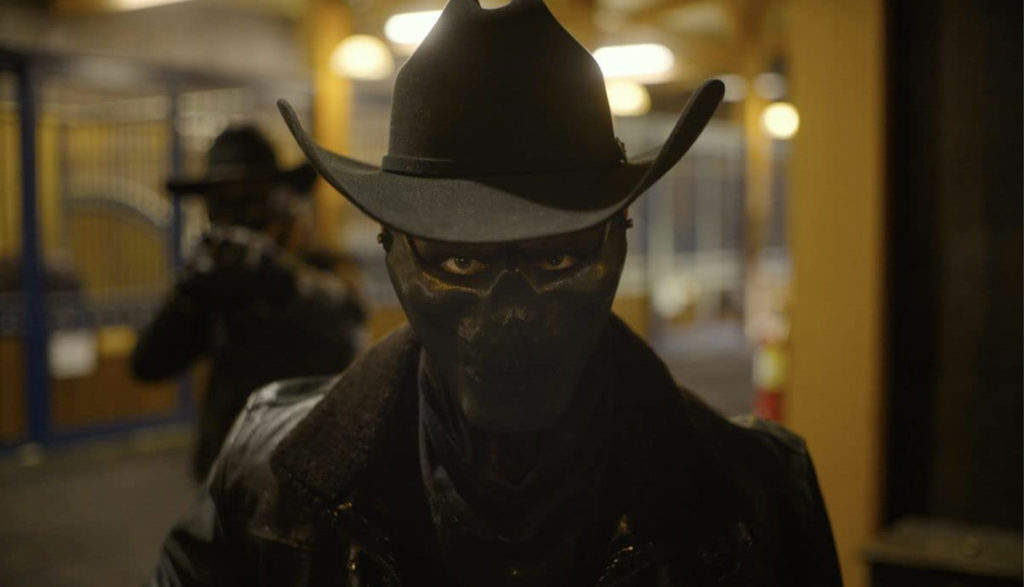
In the dystopian America of The Purge franchise, the fictional political group known as the New Founding Fathers of America (NFFA) created the Purge to help “purify” the country.
One night a year, for 12 hours, all crime is legal. Americans are encouraged to “purge” themselves of their anger and hatred through whatever means necessary—robbery, destruction of property, rape and especially murder.
In some ways, the Purge actually worked. Crime during the other 364 days of the year became almost nonexistent. And with the exception of Purge night, people actually felt safer.
But it also caused a lot of problems. As we learned in The First Purge, poorer communities were often targeted because of their inability to pay for protection. The Purge: Anarchy taught us that the rich would pay mercenaries to capture innocents so they could purge for sport. And in The Purge: Election Year, we saw how many children were traumatized (and orphaned) by the Purge as they watched their parents get murdered. One such orphan, after getting elected to the office of the President many years later, abolished the Purge entirely.
Unfortunately, the NFFA eventually came back into power. And the first thing it did was reinstate the Purge. Only this time, one night won’t be enough.
Angered by their inability to wreak havoc in previous years, bands of “Forever Purgers” form around the country. And when the sirens blare, announcing the end of the annual bloodletting event, they continue to (illegally) kill thousands of people as they leave the safety of their homes.
In response to the chaos, Canada and Mexico open their borders to unarmed refugees, prompting a Texan rancher to seek asylum with his family and his Mexican immigrant employees.
But first, they’ll have to fight their way through throngs of Forever Purgers to reach the safety of Mexico.
The issue of illegal immigration is integral to the storyline here, since many of the Forever Purgers wish to rid America of foreigners who “rape and pillage.” However, we come to understand why people are immigrating and how some kinder folks respond to their Mexican neighbors.
Juan and Adela immigrated from Mexico (albeit illegally) in order to escape the violence perpetrated by the drug cartels. They figured it would be better to live and work in a country that only has one night of violence a year rather than continue to make a living in a place where killers roam the streets every day and night.
Then there are the Tuckers, a wealthy Texas family that hires Juan to work on their ranch. Dylan, heir to the ranch, seems to dislike Mexicans and says that he doesn’t want his children to speak Spanish. His father apologizes to Juan for Dylan’s rudeness.
But when push comes to shove, Dylan and Juan put aside their differences to protect each other. After the two men save each other’s lives, they come to an understanding that it doesn’t matter where you come from or how different you are. What matters is that you’re willing to learn and help each other out. This message gradually spreads across America, as we later learn that ordinary Americans band together against the Forever Purgers, despite their differences, to put a stop to the violence.
We see several instances of people protecting each other. A man lays on top of his wife to shield her from flying bullets. When Dylan’s pregnant wife expresses her fear to have a child in such a violent world, Adela and other Mexican women reassure her. Those women also demonstrate how love can triumph over evil by protecting her and helping her escape to Mexico so she can safely give birth.
A Native American man helps several refugees. A man gives his employees a “Purge Protection Bonus” so they can purchase whatever they need to stay safe.
A cross hangs on someone’s wall. We see pictures of churches and crucifixes. Candles surround a statue of Mary, the mother of Jesus. A prerecorded message announcing the Purge says, “Blessed be our New Founding Fathers and New America.” It also says, “God be with you all.” Someone says, “God’s honest truth.” Another uses the phrase “God-loving country.”
Two married couples kiss several times. A man makes suggestive comments to his pregnant wife.
From start to finish, we see violence—usually murder—taking place. People are beaten up, tackled, stabbed, shot (with guns and arrows), dragged through the streets and blown up. Some of these murders we see from a distance as they are broadcast on televisions, others are close up, with lots of blood splatter.
Some people are caught in traps so that their assailants can torture them. When a van filled with torture victims passes by, a woman is warned not to shoot the perpetrators since they will then come after her.
A woman says that the gunshots on Purge night sound like many nights in Mexico. (We later learn she was part of a vigilante group of women who fought against the drug cartels.) A man with a swastika tattoo enjoys the gunshots, saying it sounds like music.
People throw flaming Molotov cocktails, and we see cities burning. We hear that first responders are overwhelmed. We watch a sheriff’s van get blown up with a rocket, and see several emergency vehicles and hospitals destroyed by the Purge.
The NFFA invokes martial law, and we see military personnel sweeping the streets, warning people to return to their homes and using tanks against those who refuse. (A few innocents are knocked off their feet by an explosion.) We later see that the Forever Purgers blew up a military base.
A man wears a necklace with the body parts of his victims. We see people tied up and lined up to be executed. A woman pushes her thumbs into a man’s eye sockets when he attacks her. Her friend then breaks his neck with his bare hands. People use attack dogs. A wolf eats a human carcass lying in a yard. We see multiple corpses lying about. There is a picture of a noose. Several animal carcasses hang in a butcher’s shop. A woman is knocked unconscious when a motorcycle hits her.
There are about 40 uses of the f-word (some paired with “mother” and some in Spanish, accompanied by English subtitles). We also hear a dozen or so uses of the s-word, four uses of “d–n,” three of “h—,” two of “b–ch” and one each of “a–,” “a–hole” and “p-ss.” God’s name is misused seven times (four of which are paired with “d–n” or “d–mit”). And Christ’s name is also abused once.
People drink beer and wine. A purging woman acts as though she is high on drugs, but it’s possible she’s just insane.
The Purge franchise falls under the “horror” genre, and it’s not hard to see why. There are multiple jump scares throughout the film, and Purgers often wear horrifying masks (some resembling demonic creatures).
But there’s something even more terrifying happening here—people aren’t just murdering each other in the streets, they’re celebrating their anger. A man seeking peace points out that the Purge doesn’t cure anger, it grows it.
So, while the average American purchases weapons for protection in the movie, we also see many who say that “Purging is American.” These people purchase weapons, develop traps and host “Purge Parties” to evoke that anger.
It brings out the worst of humanity. And it’s not like that anger dissipates after Purge Night is over. These people plan out what they want to do and who they want to target over the next 364 days of the year. And as The Forever Purge teaches us, even that level of extreme violence is unable to sate the purgers.
A poor man tries to teach the Tucker family what it’s like to be impoverished by threatening to kill Dylan’s sister unless a ransom is paid. However, he also tells Dylan that no matter how much money is offered, he’ll still kill her, because that’s what it’s like to be poor—to not have enough money to save your family because they’re sick or there’s not enough food or protection from the Purge is too expensive. And unfortunately, he doesn’t see the hypocrisy of participating in the Purge to show others what it’s like to be poor in the Purge.
Although we learn that Dylan isn’t racist, we do see other instances of racism. One man calls Juan a “brownie,” while another sporting a swastika tattoo targets a Mexican woman and black man. We also see several people illegally crossing the border into America.
The central problem with the entire Purge franchise is that it tries to show the best of humanity by bringing out the worst of it. Moreover, the series wants us to believe that our world could become (or even is becoming) like the one depicted in its films by drawing parallels between current political figures (it shows a wall between Mexico and America, for instance) and those in the fictional New Founding Fathers party.
We ultimately witness the NFFA being destroyed by its own system. The “good” Americans band together against the Forever Purgers to stop the violence. But if we’re being honest, wouldn’t those same people have voted against the NFFA? And even if they hadn’t, couldn’t they have banded together to stop the Purge from happening a long time ago?
Then again, this movie’s central premise doesn’t really invite that kind of logical thinking. It invites viewers to condemn one side as evil and embrace the other as the embodiment of goodness. Critical thinking here? Nah. It’s all black and white with no nuance in between.
Apart from the political ideas this franchise tries to unpack, there’s still all that gruesome violence to deal with—graphic brutality dished out even by the “good guys.” The movie’s thin philosophical veneer simply serves a pretext for wanton horror-thriller bloodshed. And the bloodletting doesn’t stop until the credits roll. Cursing is also frequent, with profanities (including the f-word) totaling near a hundred instances.
The Forever Purge fancies itself a provocative think piece about whether letting people express their anger is helpful or not. But it’s not a movie anyone needs to see in order to have a meaningful conversation about the state of America’s politics today.


Emily studied film and writing when she was in college. And when she isn’t being way too competitive while playing board games, she enjoys food, sleep, and geeking out with her husband indulging in their “nerdoms,” which is the collective fan cultures of everything they love, such as Star Wars, Star Trek, Stargate and Lord of the Rings.